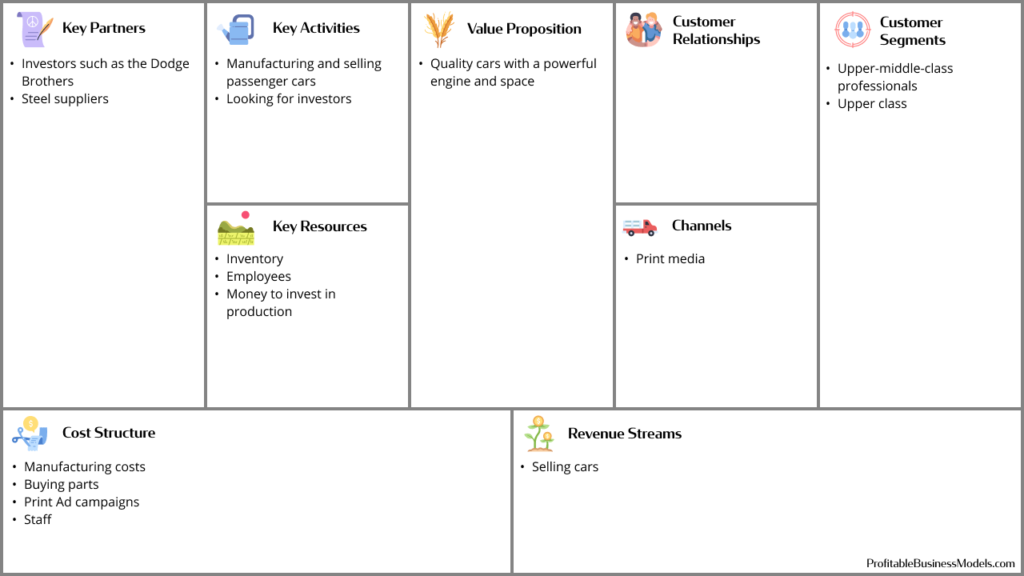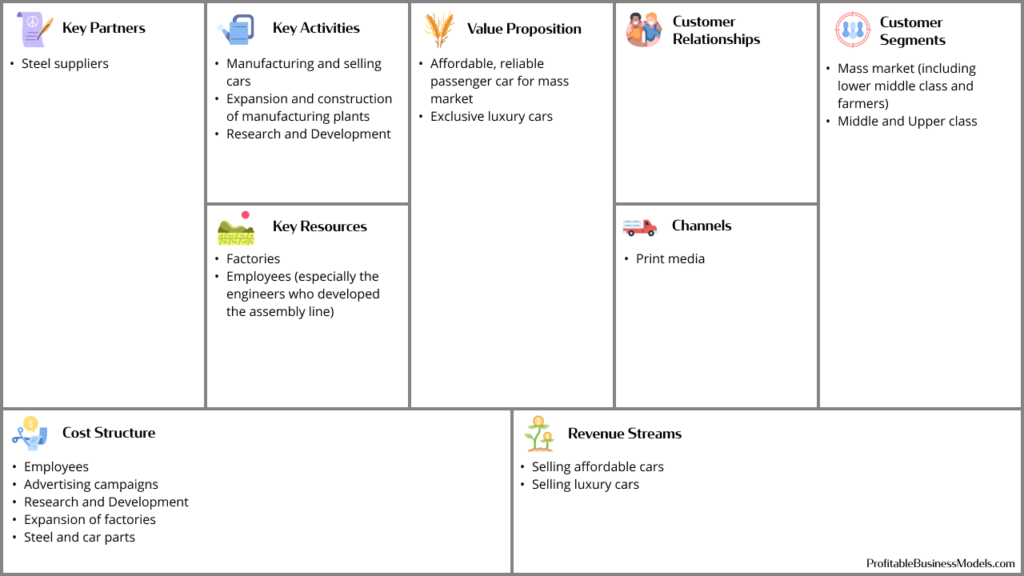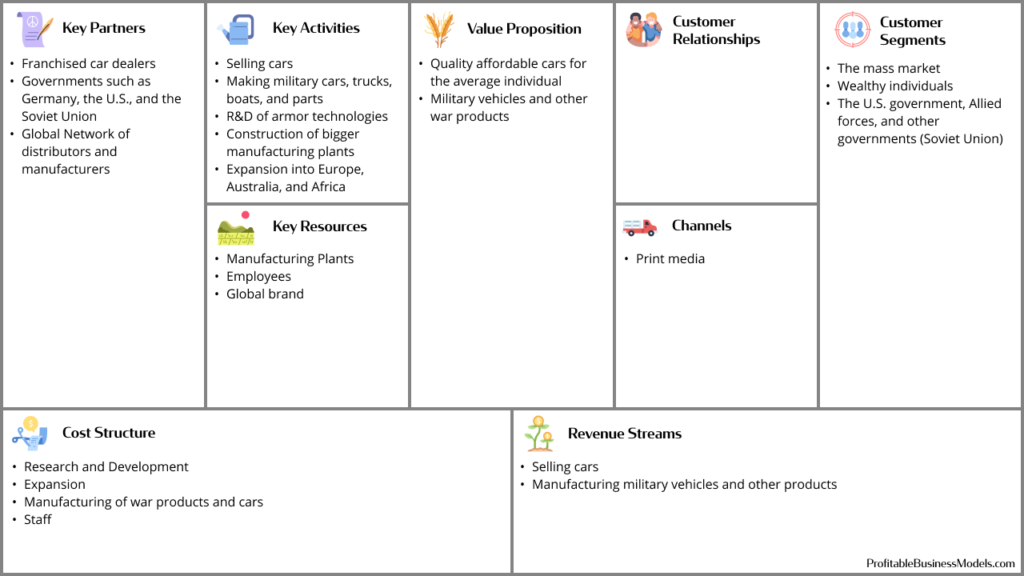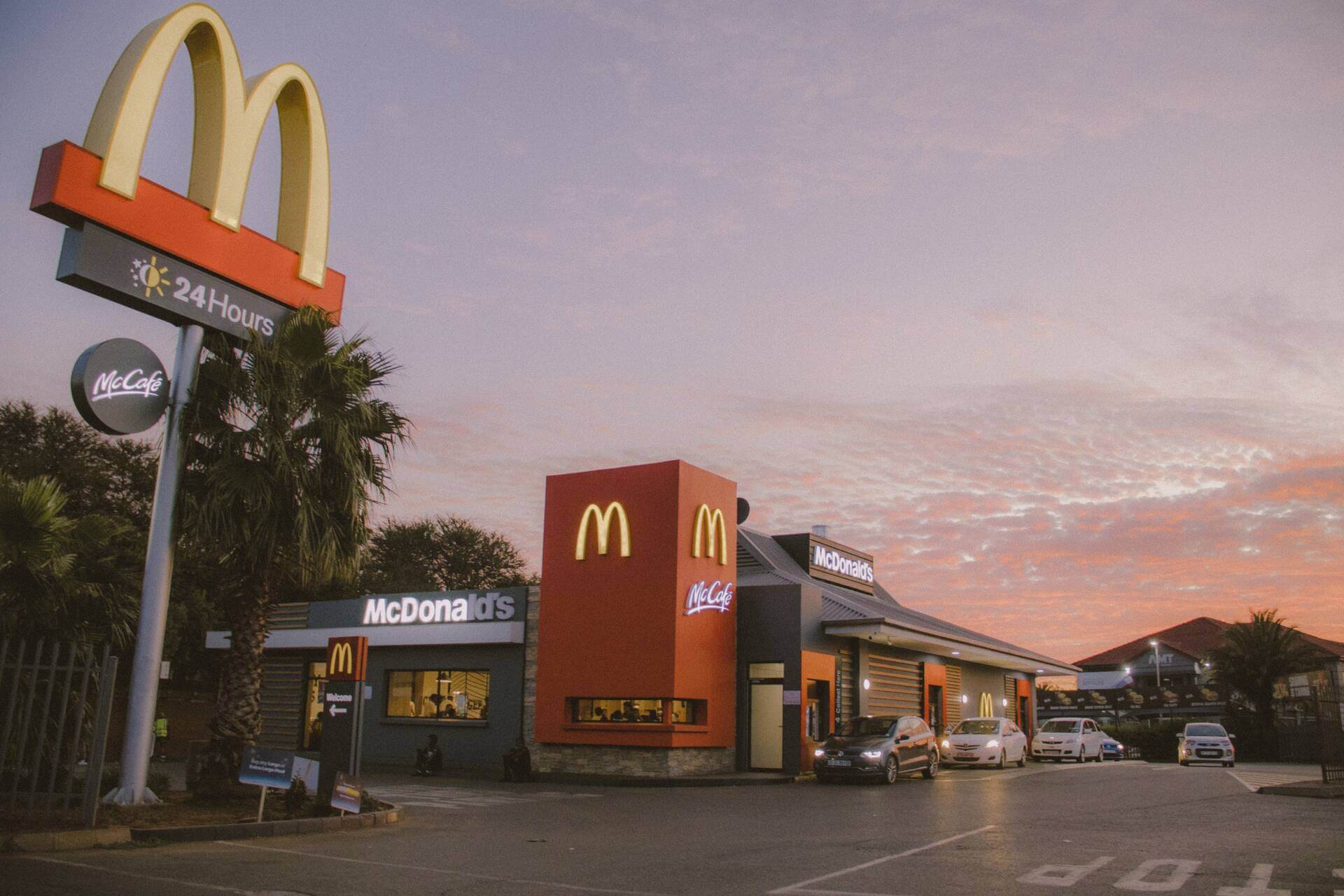Is there anything more American than Ford? As the world’s fifth-largest automaker, this automobile giant is responsible for transforming the automobile industry, working life, and transportation in general.
At the end of 2020, the Ford Motor Company’s revenue was around $127 billion. It had a 13.9% market share in the U.S., trailing only second behind General Motors. It’s no secret that the Ford Motor Company is one of America’s iconic corporations. It’s one of the biggest companies to come out of America and is an excellent symbol of the much sought-after ‘American Dream.’
But how did Ford survive the Great Depression and two world wars? How could this corporation achieve such longevity? In this article, we take a look at the rich history and early business model canvas of one of the most well-known car makers in the world under the leadership of Henry Ford.

1896-1929: The Beginning of Ford Motor Company History
1863-1902: Before Ford Motor Company was formed
Born in 1863, right after industrialization had changed the way people lived for good. Henry Ford was the first surviving son of William and Mary Ford, prosperous farmers who lived in Dearborn, Michigan.
He left home at 16 for Detroit, where he found employment as a machinist. After a few years, he returned home but continued to operate and service steam engines and worked occasional jobs in factories in Detroit.
In 1891, he returned to Detroit with his wife, Clara. He was hired as an engineer for the Edison Illuminating Company. He quickly rose through the ranks, and in 1893 he was promoted to chief engineer.
Clearly, Ford was no stranger to invention and automation. He was a product of the times and designed his first vehicle called the Quadricycle in 1896. It rode on four bicycle wheels and was powered by a four-horsepower pure ethanol engine.
The design was pretty primitive because instead of a steering wheel, the bicycle had a tiller. The gearbox had only two forward gears and no reverse option. Nevertheless, it was a pretty nifty invention.
1899-1901: The Detroit Automobile Company (the precursor to the Ford Motor Company)
Determined to improve upon his prototype, Ford resigned from the Edison Illuminating Company in August 1899 to start his own venture, the Detroit Automobile Company.
He sold the Quadricycle to fund the building of other vehicles. He persuaded some of his acquaintances and colleagues, including William Murphy and Lemuel Bowen, to come on board and finance the Detroit Automobile Company, later renamed the Henry Ford Company.
However, his partners were eager to put a passenger car on the market as soon as possible. They grew frustrated with Ford’s constant need to improve his vehicles. The tension rose to an all-time high as the company faced bankruptcy within 18 months from its inception. Ford left the company with the rights to the name and $900, it was then that he uttered for the first time his famous phrase:
“Failure is merely the opportunity to begin again, this time more intelligently.” With this guiding principle in mind, Ford regrouped and established the Ford and Motor Company in 1902.
Meanwhile, Murphy and Bowen regrouped and formed the Cadillac Motor Company in August 1902.
1903-1906: Reorganizing and Forming the Ford Motor Company
Finding Investors & Partners
To help finance his new company, Ford turned to an acquaintance named Alexander Y. Malcomson, a coal dealer. Malcomson forked out the money to start the partnership “Ford and Malcomson.” The two decided to design a car and began ordering parts from a manufacturing firm named John and Horace Dodge.
However, by February 1903, Ford and his partner Malcomson had spent more money than expected. The manufacturing firm they had hired to make parts was demanding payment. Malcomson didn’t have any more money to spare as he was spread thin already due to the demands of his coal business.
So Malcomson turned to his uncle John S. Gray. The latter was the president of the German-American Savings Bank and an extremely close friend. Malcolmson convinced him to invest in the upstart Ford Motor Company. Gray wasn’t interested at first, but Malcomson promised that he could withdraw his share at any time. Reluctantly, Gray agreed.
Malcomson proposed incorporating the Ford and Malcomson partnership to bring in more investors. Fortunately, Gray’s prominent reputation encouraged others to invest in the automaker too.
The new investors included lawyers John Anderson and Horace Rackham, local merchants Albert Strelow and Vernon Fry, Charles T. Bennett of the Daisy Air Rifle Company, and his own clerk James Couzens. Malcomson also convinced their manufacturing partners John and Horace Dodge to accept stock instead of payment.
Incorporating The Ford Motor Company and the birth of the Ford Model A Car
Finally, on 16 June 1903, the Ford Motor Company was incorporated, with 12 investors owning a total of 1000 shares. Ford and Malcomson were the biggest shareholders, retaining 51% of the new company. During the first stockholder meeting held two days later, Gray was elected president and Ford vice-president.
One of the new company’s investors, Albert Strelow, was the proud owner of a successful wooden factory building on Mack Avenue. He rented the factory out to the company so that operations could begin. Ford’s employees assembled automobiles from components made elsewhere by the Dodge Brothers’ manufacturing firm.
However, things were not so rosy. In fact, by the time the company sold the first Ford Model A car on 23 July 1903, almost all of the $28,000 cash investment was gone.
Nevertheless, this first order from a dentist named Ernst Pfenning was the signal of the many great things to follow. The car sold at $850, and within two months, the company had sold 215 Fords following successful print ad campaigns. The car appealed to many upper-middle-class professionals as well as the upper class.
The Model A was an instant hit for a couple of reasons. It could easily accommodate two people side-by-side on a bench, and it also had a four-seater option. The car had no top and was painted red.
Aside from the pleasing aesthetics, the car’s biggest selling point was the engine itself. It had two cylinders and eight-horsepower, which was the most powerful engine on a passenger car.
By the end of October, the Ford Motor Company had almost $37,000 in profit. The Mack Avenue plant they were operating from had produced close to 1,000 cars at the end of the year. Everyone wanted a piece of the action.
Ford’s Business Model Canvas: The Early Days
At this point, Ford’s Business Model Canvas looked like this:
Value Proposition
- Quality cars with a powerful engine and space
Customer Segments
- Upper-middle-class professionals
- Upper class
Customer Relationships
Channels
- Print media
Revenue streams
- Selling cars
Key activities
- Manufacturing and selling passenger cars
- Looking for investors
Key resources
- Inventory
- Employees
- Money to invest in production
Key partners
- Investors such as the Dodge Brothers
- Steel suppliers
Cost structures
- Manufacturing costs
- Buying parts
- Print Ad campaigns
- Staff

1904-1912: Early Expansion, Some Internal Turmoil & Huge Success
In 1904, the Ford Motor Company expanded into Canada. However, it was not a subsidiary of the original company; instead, it was a separate organization with its own shareholders. The primary purpose of this enterprise was to expand not just in Canada but also across the British Empire.
The Canadian plant was based in Walkersville (now Windsor), Ontario, across the Detroit River from Ford’s existing facilities. In 1905, the automobile maker moved operations to a much larger facility on Piquette Avenue in Detroit’s Milwaukee Junction area.
However, things were not going well internally. There was a lot of friction regarding the governance and direction of the company. Moreover, most of the investors, including Gray and Malcomson, had their own businesses to attend to. So only Ford and Couzens were full-time employees of the company.
The tension escalated when the major shareholders Malcomson and Ford, disagreed over the company’s direction. Malcomson wanted the company to manufacture larger luxury cars. While they might sell fewer, he believed they would make a higher profit per car.
Ford was not a fan of the idea at all. Instead, he wanted the company to produce low-priced cars that targeted the mass market. He believed this would lead to greater sales and higher profits based on the volume produced. Malcomson, however, continued to push for big luxury cars and eventually won.
The Model B & Model K Cars: Complete Disappointment
So in 1905, Ford launched the Model B. It was the first four-cylinder car from Ford and the first to have the engine mounted upfront in the European manner. They priced it at $2,000, and it sold poorly.
The following year Ford launched an even more expensive car named the Model K. It was meant to replace the Model B. The Model K had six cylinders, and it cost $2,500. Once again the sales were extremely disappointing.
Following these launch disasters, Malcomson was frozen out of the Ford Motor Company in early 1906. In May, he sold his shares to Henry Ford. That same year John S. Gray died suddenly, leaving Ford holding the reins of the company.
The Model N
Now in control, Ford set out accomplishing his vision. He stated that “…the greatest need today is a light, low-priced car with an up-to-date engine with ample horsepower, and built of the very best material.… It must be powerful enough for American roads and capable of carrying its passengers anywhere that a horse-drawn vehicle will go.”
And that’s what the Ford Model N was. Introduced in 1906, the Model N was immediately popular among middle-class Americans. It was fast and rugged with four cylinders and a shaft drive, plus at $500, it was very affordable. By the end of the year, the Model N had become the best-selling car in America.
Ford’s goal of allowing the average American to own and enjoy a car was well underway. However, he hadn’t forgotten about his upper-middle and upper-class clients. He followed the Model N with fancier Models R and S in 1907, selling at $780.
That same year Ford introduced their new logo. It had been designed by an engineer named Childe Harold Wills, who was one of the first employees to join the company. The logo made its first appearance in a print ad for the Model R with the slogan ‘Watch the Fords Go By.’ The campaign and the logo resulted in a 35% market share increase for Ford.
1908-1912: The Model T Ford’s Biggest Success
The following year Ford opened its first overseas branch in Paris. While Henry was focused on expanding into Europe, he was also dealing with a few problems back home.
You see, the U.S. had only about 18,000 miles of paved roads; the rest were primitive at best and downright un-drivable at worst, especially in bad weather. He used light and strong vanadium steel alloy for critical parts to ensure that his cars could handle the strain.
And while the Model N was aimed at the mass market, it was still beyond the reach of the average American, especially those with families. In fact, most of the automobiles in existence were luxurious novelties that fit two to four people rather than affordable transport.
Henry realized that he needed to improve his designs, ensuring that his vehicles were reliable and easy to maintain for the millions of new drivers he intended to capture. The business model was simple but effective. He wanted to build quality cars that could out-perform vehicles from the competition.
The cars had to be rugged enough to drive over largely unpaved roads and easier to maintain and service than other cars. So in September 1908, he launched the Model T; it was an affordable car that was big enough for families. The car included several technical innovations that made it lightweight, rugged, and inexpensive compared to other cars of its size.
The Model T was so sought after that it strained Ford’s production capacity. The car was so successful that Ford did not purchase any form of advertising between 1917 and 1923. Barely six months after the car’s debut, the company had to stop taking new orders until it could catch up with those already placed.
To counteract the problem, Ford purchased a piece of land and began constructing a new factory in Highland Park, Detroit. The factory had facilities for machining, stamping, casting, assembling, and shipping. The plant opened in 1910, becoming the second production facility for the Model T.
The Model T was not only for town dwellers; it appealed to and proved particularly beneficial for farm families. While those in the city had plenty of access to streetcars, railroads, bicycles, and paved roads, farmers were limited to the distance his horse or feet could travel.
The affordable Model T, with its sturdy construction and durability, ended that isolation for good. By the end of 1911, the Ford Motor Company had a whopping 25,000 employees producing as many Model T cars as possible.
1913: The Assembly Line
While the new factory did help to ease some of the production delays, it was not enough. The production process up to this point was chaotic and expensive. Each car chassis was propped up on a sawhorse, and different teams of skilled workers would move from one car to the next, installing parts as they went.
This meant that every part needed a highly-skilled craftsman who could put together certain components of complex machines. So it took an insanely long time for one car to be completed and sometimes there were standardization issues.
Clearly, the old method of assembling parts by hand was no longer sufficient. Henry realized that he needed to find a way to mass-produce the insanely popular Model T.
He tasked Ford engineers with the task, and they set out to find a workable solution. They studied various techniques and processes in other industries, eventually landing on meatpackers who used moving disassembly lines. Conveyors moved carcasses past meat cutters, who then sliced off multiple pieces of the animal.
While it was an unusual source of inspiration, it was what Ford needed. So in 1913, they adapted this technique to their factories, developing the moving assembly line in stages. They started at the magnetos (the generators that produce electricity for the spark plugs) sections.
Each worker on the line was responsible for one part, shoving the flywheel onto the next employee, who would then add the next part and so on. This 1913 assembly line was relatively crude — workers pushed or pulled vehicles to each station.
Once they saw that the idea worked, the engineers applied the concept to more complex items like transmissions and engines.
This new system cut production times from 12 ½ hours to just 2 hours and 40 minutes and allowed Ford to keep costs low. It was at this point that Ford severed its manufacturing relationship with the Dodge brothers. The company could now make and assemble all the parts they needed within their own factories.
The Dodge brothers then decided to start their own automobile company, Dodge Brothers Motor Company, beginning a rivalry that would intensify during the next few years.
Consolidating the Production Process
Ford didn’t stop at the assembly process. He realized that to streamline the whole production process he needed to diversify the company’s business interests. He purchased several village industries to gain better control over oversupply.
This meant that the Ford Motor Company was now in complete control of all the means of production. The company became its own supply line, acquiring energy resources, raw materials, and transportation assets necessary to support the entire business. Ford was no longer reliant on suppliers who could spike their prices without warning.
Ford’s Business Model Canvas: The Stabilization Days
At this point, Ford’s Business Model Canvas looked like this:
Value Proposition
- Affordable, reliable passenger car for mass market
- Exclusive luxury cars
Customer Segments
- Mass market (including lower middle class and farmers)
- Middle and Upper class
Customer Relationships
Channels
- Print media
Revenue streams
- Selling affordable cars
- Selling luxury cars
Key activities
- Manufacturing and selling cars
- Expansion and construction of manufacturing plants
- Research and Development
Key resources
- Factories
- Employees (especially the engineers who developed the assembly line)
Key partners
- Steel suppliers
Cost structures
- Employees
- Advertising campaigns
- Research and Development
- Expansion of factories
- Steel and car parts

1914-1929: Expansion and Fighting for Dominance
Competition with Dodge, Shareholder, and Employee Issues
While the assembly line was an excellent system for productivity and profits, it reduced highly skilled workers into part of a machine. Many of them found themselves working on a single, routine task every day, all day.
By the beginning of 1914, the employee turnover rate was 380%. So in January, Henry announced that he would pay his workers $5 for an eight-hour day, 5-day workweek, thereby introducing the idea of a “weekend”. This was the first time the concept of giving workers a break from work was implemented and it was a big deal.
The weekend perk and the more than double rate (which was $2.34 before) was too good a deal to pass for most workers. This strategy worked, and sales increased mainly because his line workers could now afford to buy a Model T with less than four months’ pay.
Meanwhile, the Dodge Brothers Motor Company launched their own car, the Model 30-35. This car was intended to compete directly with the Model T.
Henry did not like that his former partners were hot on his trail, so he decided to take down the competition.
He stopped paying dividends to the Dodge brothers, who still had a 10% stake in Ford Motor Company. The Dodge Brothers sued Ford. Henry claimed that he was using the money meant to pay out the dividends to improve his worker’s wages. The court did not accept his explanation and ordered him to pay his investors the dividends owed to them.
Henry’s next move was to slash the price of his cars by two-thirds; he also created a system of franchised dealers who were loyal to his brand name.
Ford and WWI
When World War I started, the whole automobile industry was heavily affected. At first, Henry was heavily against the war and even commissioned a ship in 1915 to go to Norway to try and convince European officials to stop the war.
When the mission failed, he realized that he had no choice but to try and support the war effort when American entered the conflict in 1917. From the spring of 1917 through to autumn 1918, Ford factories supported the war effort by producing war boats, cannons, military trucks, and many other war products.
The Model T design was so good that it served as the foundation for war ambulances, trucks, and service vehicles manufactured during the war. It could traverse the war-torn environment, could maneuver easily, ensuring that medical professionals could tend to the wounded quicker than ever before.
The company also committed to research and development work on various armor technologies for vehicles and soldiers.
1918-1929: Resuming Normal Activities
As soon as the war ended, Ford resumed production of their Model T. However the company was still facing challenges with the Dodge brothers. Ford had begun construction of a massive industrial complex situated along the banks of the River Rouge in Dearborn, Michigan.
The factory combined all the components necessary for auto production, including a glass factory, steel mill, and assembly line. Sensing the threat to their own business and dividend payout, the Dodge brothers and the other shareholders resisted the idea due to its enormous costs.
Henry became determined to buy out the remaining shareholders. He installed his son Edsel as president of the Ford Motor Company. He threatened to leave to set up a rival company. The news spread, driving down the share value of the company. Thankfully, the idea worked, and Henry bought out all the minority shareholders, including the Dodge brothers, for $125 million by 1920.
Meanwhile, Ford factories opened up everywhere, in Ireland, England, and France, in 1917. Denmark, Germany, Austria, and Argentina followed a few years later, and by 1925 there were factories in Japan, South Africa, and Australia.
In 1922, Ford purchased the Lincoln Motor Company as a move towards the luxury auto market. By the end of the 1920s, Ford was producing 50% of the cars in the U.S. and 40% of all British ones.
1927-1929: Losing Market Share
However, the success of the Model T proved to be its undoing. While it was touted as the universal car, Ford kept producing the same car for 19 years without significant design or engineering changes.
What was considered state-of-the-art in 1908 was, of course, outdated two decades later. Realizing that the Model T’s run was ending, Edsel and Henry Ford drove the fifteen-millionth Model T out of Highland Park Plant in May 1927. This marked an end to the Model T production.
Ford was slowly losing market share to General Motors and Chrysler, among other competitors offering more innovative features and luxury options. General Motors, for example, had cars that ranged from affordable to luxury, tapping into a broader customer segment spectrum.
The Model T was now relegated to lower-middle and middle-class individuals who purchased used Model Ts. Those with the money for new Model Ts preferred to buy from G.M. and Chrysler. Additionally, G.M. and other competitors started allowing credit purchases with monthly payment options.
Initially, Ford resisted this approach, fearing that such debts would hurt their bottom line and the economy. However, seeing how much their competitors benefited from such payment arrangements, Ford started offering credit purchases in December 1927.
1930-1947: Surviving the Great Depression, Competition and Controversy
Ford and the Soviet Union
Itching for the next successful venture, Henry inked a deal in late 1929 with the Soviet Union. The country purchased $13 million worth of parts and automobiles. In return, Ford agreed to give the Soviet Union technical assistance until 1938. Many Americans relocated to the Soviet Union to work on constructing the Ford plants and their production lines.
These Soviet factories produced the German model of the Ford Model A passenger car named the GAZ-A and a light truck called the GAZ-AA. Both models were used by the military.
The Great Depression and Rising from the Ashes
When the Great Depression began in 1930, no business was spared, including Ford. They had to lay off workers and scale back production. Henry committed to helping a small number of families with loans and parcels of land to work.
However, he angered many by suggesting that the unemployed should do more to find their own work. In response to his statements, angered workers and members of a society organized the Ford Hunger March on 7 March 1932.
At least 5,000 unemployed workers marched to Ford’s River Rouge plant to deliver a petition demanding more support. Unfortunately, the protest became violent, and five men died, with sixty more seriously injured.
Despite the relative success of the Model A, it proved to be a disappointment. It was outsold by General Motors’ Chevrolet and Chrysler’s Plymouth passenger vehicles. Ford had used an old-fashioned, personalized management system and neglected consumer demand for improved cars. By 1931 Ford had discontinued the Model A.
The 1930s were a tough time for the Ford Motor Company. They were struggling to maintain dominance amid the rise of better cars by competitors and the effects of the Great Depression. To add to the company’s woes, Ford became engaged in a long battle against labor unionization.
Henry was refusing to come to terms with the rise of the United Automobile Workers (UAW) even as competitors did. Things became heated in 1937 when Ford security staff clashed with UAW members. Ford was ordered to stop interfering with the union organization by the National Labor Relations Board.
Ford and WWII
As with the First World War, Henry refused to participate in the war. He was still an advocate for peace, and while the U.S. remained neutral, Ford focused on its usual operations. The company was hesitant to participate in the Allied military effort.
Additionally, Ford had a subsidiary in Germany and was eager to keep the German business running. He had a close relationship with Germany before the war. This relationship kept Ford factories in Germany relatively safe when many foreign-owned factories were taken over by the Nazi Government. Ford kept 52% of his ownership, though with no control or financial gain.
The Ford factories in Germany were a significant part of building up the German Armed Forces. However, it was Pearl Harbour that led to the company contributing hugely to the war effort. After the war, the Treasury Department investigated Ford for collaboration with the German-run Ford plants in occupied France. They did not find conclusive evidence.
1943-1947: A Desperate Set of Circumstances
In 1943, Edsel Ford died of stomach cancer, and Henry decided to resume direct control of the company. Still, he was 78 years old and suffering from heart problems and atherosclerosis. Additionally, his mental state and decision-making capabilities were questionable; there was a genuine possibility that the company would crumble if he died or became incapacitated.
As the Ford company had become a big part of the American economy and the war effort, the Roosevelt Administration came up with a contingency plan to nationalize Ford should the need arise. At this point, Ford’s daughter-in-law and wife intervened by demanding that Henry turn control over to his grandson Henry Ford II.
Henry resisted the idea, and the women threatened to sell off their stock which would amount to half its total shares if he refused. Infuriated, Henry had no choice and finally agreed to allow Henry II to assume command of the Ford Motor Company in 1945. When Henry II took over, the company was losing US$9 million a month and incomplete financial chaos.
Henry Ford died on 7 April 1947, and Henry II took over as Chairman and CEO. Henry Ford II reorganized the company’s tangled system of financial management. He managed to revamp its corporate culture by hiring talented younger managers such as Robert McNamara.
Ford’s Business Model Canvas: The Dominance Days
At this point, Ford’s Business Model Canvas looked like this:
Value Proposition
- Quality affordable cars for the average individual
- Military vehicles and other war products
Customer Segments
- The mass market
- Wealthy individuals
- The U.S. government, Allied forces, and other governments (Soviet Union)
Customer Relationships
Channels
- Print Media
Revenue streams
- Selling cars
- Manufacturing military vehicles and other products
Key activities
- Manufacturing and selling cars
- Making military cars, trucks, boats, and parts
- Research and development of armor technologies
- Construction of bigger manufacturing plants
- Expansion into Europe, Australia, and Africa
Key resources
- Manufacturing Plants
- Employees
- Global brand
Key partners
- Franchised car dealers
- Governments such as Germany, the U.S., and the Soviet Union
- Global Network of distributors and manufacturers
Cost structures
- Research and Development
- Expansion
- Manufacturing of war products and cars
- Staff

Conclusion
Henry Ford led his company through two world wars, a great depression, and a rapidly growing economy. While some decisions were late and ill-advised, he managed to keep his company profitable throughout different economic seasons.
The adaptability and innovation it took to keep such a big company running is extraordinary. There are a few lessons we can learn from Henry Ford, but the most important should be: “Failure is merely the opportunity to begin again, this time more intelligently.”
Sources
- https://corporate.ford.com/about/history/company-timeline.html
- https://en.wikipedia.org/wiki/History_of_Ford_Motor_Company#cite_note-ind-2
- https://www.statista.com/topics/1886/ford/#topicHeader__wrapper
- https://www.history.com/this-day-in-history/ford-motor-company-incorporated
- https://www.history.com/topics/inventions/henry-ford
- https://www.britannica.com/topic/Ford-Motor-Company/Reorganization-and-expansion
- https://www.osv.ltd.uk/brief-history-of-ford/
- https://auto.howstuffworks.com/henry-ford-vs-dodge-brothers-all-american-feud.htm
- https://www.conceptcarz.com/vehicle/z7477/ford-model-r.aspx
- https://artsandculture.google.com/exhibit/putting-the-world-on-wheels-the-ford-model-t-the-henry-ford/pAIiixLJtc1HLw?hl=en
- https://ss.sites.mtu.edu/mhugl/2015/10/12/henry-ford/
- https://www.npr.org/2014/01/27/267145552/the-middle-class-took-off-100-years-ago-thanks-to-henry-ford








